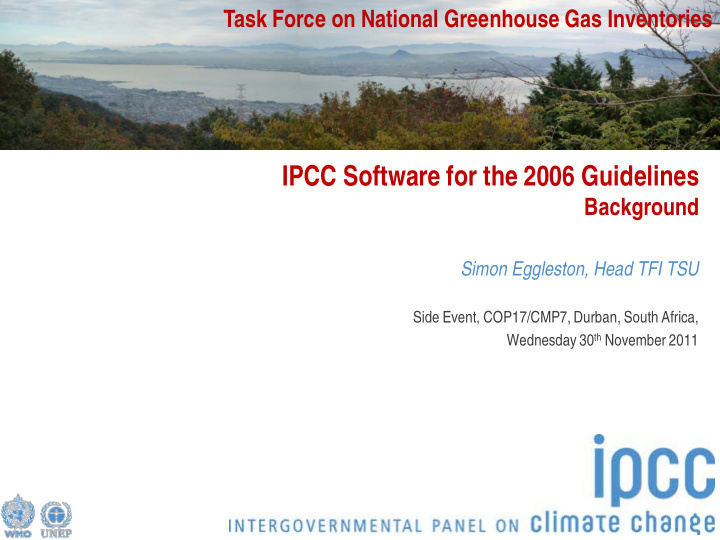



Task Force on National Greenhouse Gas Inventories IPCC Software for the 2006 Guidelines Background Simon Eggleston, Head TFI TSU Side Event, COP17/CMP7, Durban, South Africa, Wednesday 30 th November 2011
2006 IPCC Guidelines • The 2006 IPCC Guidelines for National Greenhouse Gas Inventories was approved by the IPCC in 2006. It updated the Revised 1996 IPCC Guidelines and two sets of Good Practice Guidance It was the culmination of 2½ years efforts by over 250 experts worldwide It is currently being considered by the UNFCCC for use by Annex I parties for reporting to the UNFCCC – currently Annex I Parties must use earlier guidelines It is already widely used in whole or in part 2
“Old” 1996 Software • The IPCC produced software implementing the Revised 1996 Guidelines • The maintenance of this software has been taken over by the UNFCCC Secretariat • This software Aims to be used by those with limited resources and experience Is also a valuable teaching aid Is based on the worksheets in the revised guidelines Uses MS Excel spreadsheets and macros 3
New Software for 2006 Guidelines • Following the completion of the 2006 IPCC Guidelines the TFI decided to produce new software implementing the new guidelines • An expert meeting in Doha in January 2007 considered the overall needs and design of the software • Subsequently the Task Force Bureau and IPCC Panel agreed to proceed with the development in two phases The First to produce a demonstration version for the energy sector The Second to produce the complete software • The software development was tendered and awarded to SPIRIT a.s. 4
Objectives • The objectives of the software are to: Facilitate preparation of national GHG inventories according to 2006 Guidelines either for complete inventories or for separate categories or groups of categories. assist in training and inventory review harmonise reporting of greenhouse gas inventories archive data and complete inventories (which may consist of estimates for a number of years). 5
Users of software • The primary target groups of users are: Inventory compilers in all Parties to the UNFCCC with limited resources without their own inventory systems/software and who wish to apply default methods, Trainers and trainees on national GHG inventory compilation, • In addition, a range of other potential users has been identified Reviewers of national inventories Academics/Researchers UNFCCC Secretariat Project developers 6
Design • While the software should emulate the worksheets it need not be spreadsheet based – a database approach is used. • It is modular – it can be used for individual categories and data and results can be imported and exported • It does not need powerful hardware • Software should be freely distributable • Help should be available • Languages – while the first version is in English it should be possible to add other languages 7
Functionality • Worksheets where data is entered and emissions estimated Ability to stratify and add sub-categories Default emission factors from the 2006 Guidelines should be available Global Warming Parameters or other metrics should not be fixed Notation Keys as in the Guidelines should be available • Outputs in printable tables, Excel or XML for CRF input All Reporting Tables available • Key Category Analysis and Uncertainty modules • QA/QC checks such as completeness flags • Ability to add references and comments 8
Phased Approach 9
Complex AFOLU Data Entry 10
11
Now • The software is being finalised We encourage as many people as possible to look at it and to send us any comments, bugs etc. We aim to release a complete version widely early next year • Today we want to introduce and demonstrate the software It is available for download and testing from: http://www.ipcc-nggip.iges.or.jp/support/support.html 12
Task Force on National Greenhouse Gas Inventories Thank-you 13
Recommend
More recommend